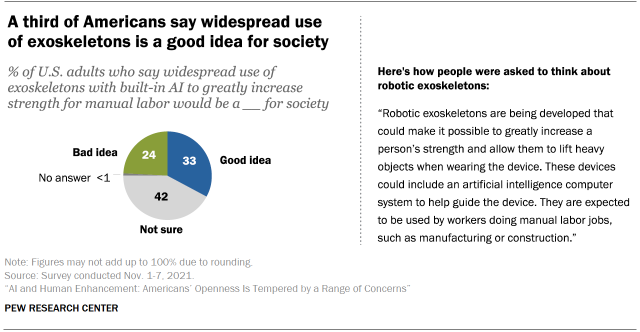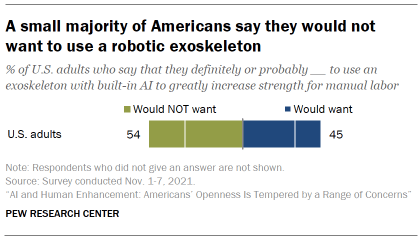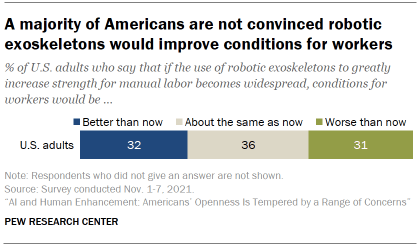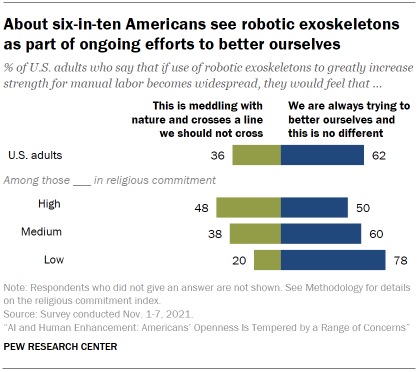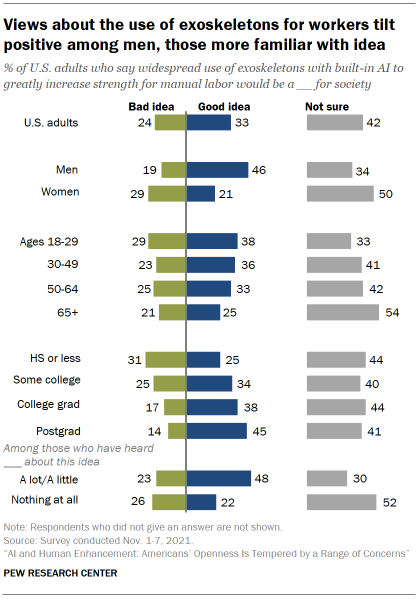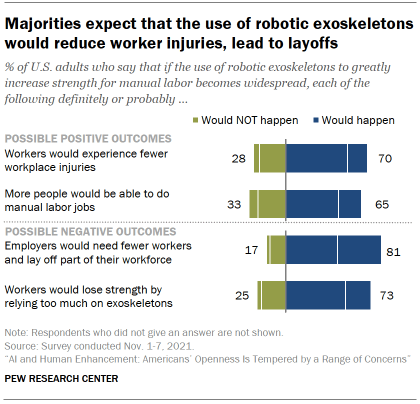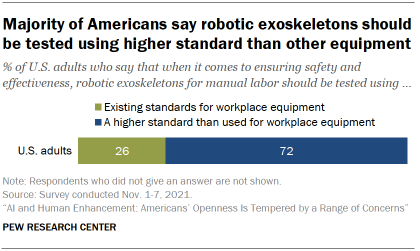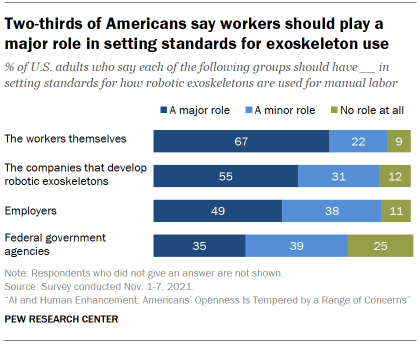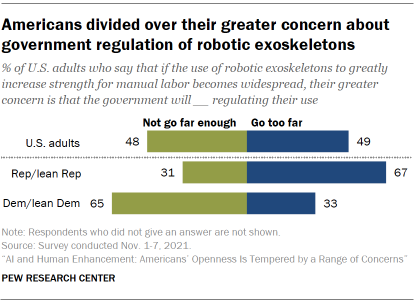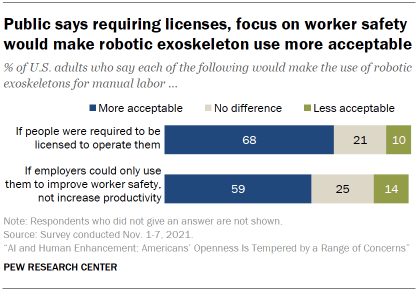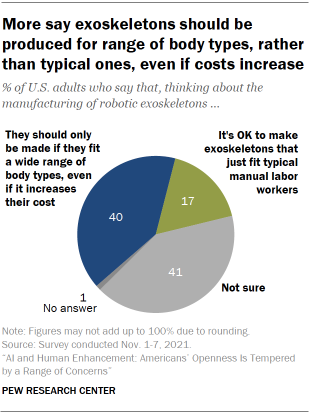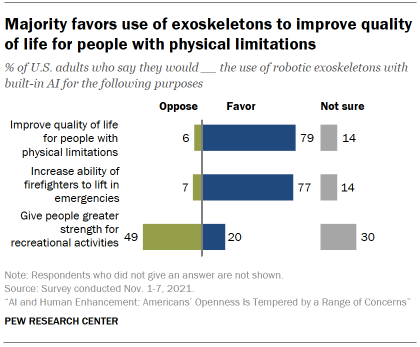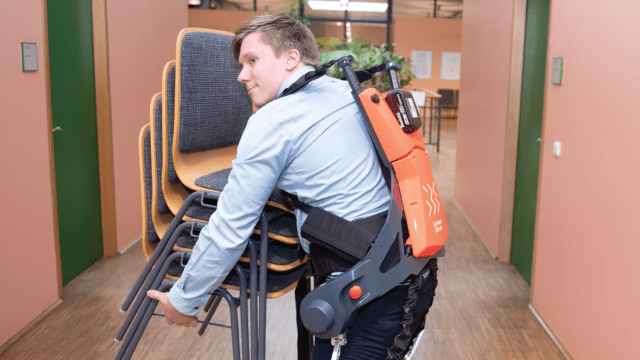
Robotic exoskeletons are an emerging technology now being developed with the potential to augment human strength. Some are in development for use in manual labor jobs to give workers increased strength for lifting heavy objects. More complex exoskeletons are sometimes called a “wearable robot,” because they include a built-in artificial intelligence (AI) computer system which uses sensor data to help guide its use.
Americans report a mix of views about the potential for widespread use of robotic exoskeletons with built-in AI to give workers in manual jobs increased strength. While a majority sees this idea as being in line with long-standing efforts to better ourselves as humans, a slightly larger share of the public say they would hesitate to use such a device than say they would want to do so.
As Americans think about the possible widespread use of robotic exoskeletons with built-in AI systems for workers in manual jobs, 33% say this would be a good thing for society, a smaller share (24%) say it would be a bad thing, and nearly double that share (42%) say they are not sure what the impact would be for society.
If given the chance, a narrow majority of Americans (54%) say they, personally, would not want to use a robotic exoskeleton for manual labor tasks; 45% say they definitely or probably would like to use one.
About two-thirds of Americans are skeptical robotic exoskeletons would improve manual labor conditions
Exoskeletons are being used and developed for a variety of purposes. These external devices that combine human and machine movement can be designed as a whole body suit, as portrayed in the Iron Man movies, or as devices to fit specific areas such as the lower body, the hand or the head, neck and shoulders. Some are aimed at therapeutic roles to help people with spinal cord injury regain use of their limbs, for example. Others are being developed for military applications, or as in this example to support industrial work. In the future, experts believe their use could extend to the general population for use in exercise or fitness activities.
In thinking about the potential widespread use of robotic exoskeletons with a built-in AI system for use in manual labor jobs, many Americans are skeptical that such devices would improve conditions for workers. About a third (32%) say that the widespread use of robotic exoskeletons in manual labor jobs would make conditions for workers better than they are now, while about as many (31%) say they would make conditions worse; 36% say that, if exoskeletons were in widespread use, working conditions would be the same as they are today.
Less than half the public raises ethical concerns about this idea. When asked which statement better describes their views about the possible widespread use of robotic exoskeletons for manual labor jobs, 62% express alignment with the view that “as humans we are always trying to better ourselves and this idea is no different.” A smaller share (36%) takes the opposing view that “this idea is meddling with nature and crosses a line we should not cross.”
These findings stand in contrast to public views about other forms of human enhancement considered in the Center survey. For example, a 63% majority of Americans say that the potential widespread use of brain chip implants to improve cognitive functioning would be crossing a line that we should not cross. And Americans are closely divided over whether the use of gene editing to greatly reduce a baby’s risk of developing serious diseases or conditions over their lifetime would be crossing a line (52%) or in keeping with ways that humans have tried to better ourselves over time (46%).
As with those other potential avenues to human enhancement, however, people’s level of religious commitment are correlated with their views about this. (Religious commitment is based on a three-item index reflecting the salience of religion in a respondent’s life, their frequency of religious service attendance and their frequency of prayer.) Among those with high religious commitment, 48% say the widespread use of robotic exoskeletons with built-in AI for manual labor jobs would be meddling with nature and crosses a line, while 50% say it’s no different than other efforts at improvement. By contrast, majorities of those with medium (60%) or low (78%) levels of religious commitment say the use of robotic exoskeletons to greatly increase strength for manual labor jobs is no different than other human efforts to better ourselves.
Men, those familiar with robotic exoskeletons are more inclined to say the widespread use of exoskeletons would be a good idea for society
Public awareness of robotic exoskeletons is limited as of now. Only 6% of Americans say they have heard a lot about robotic exoskeletons with built-in artificial intelligence, while 37% have heard a little and 57% say they have heard nothing at all.
Those who are more familiar with the idea of robotic exoskeletons with built-in AI systems are more positive about their use. People who have heard at least a little about these devices are more likely to think their widespread use would be a good idea for society (48%) than a bad one (23%). By contrast, those who had not heard at all about this idea are closely divided between whether the widespread use of robotic exoskeletons in this way would be a good (22%) or bad (26%) thing. The remainder (52%) are undecided about this.
Men are more than twice as likely to say that the widespread use of exoskeletons for manual labor would a good idea for society (46%) as to say it is bad idea (19%). By contrast, just 21% of women say this would be a good idea for society, while 29% call it a bad idea.
Those with higher levels of education are more embracing than those with less education of a future with widespread use of robotic exoskeletons with built-in AI for manual labor jobs. Among those with a postgraduate degree, significantly larger shares say the use of exoskeletons in manual labor jobs would be a good idea than bad idea for society (45% vs. 14%), and the same is true among those with a four-year college degree (38% vs. 17%). The balance of opinion is more narrowly divided among those with some college education (34% good idea, 25% bad idea). And among those with a high school diploma or less education, more say that exoskeletons are a bad idea (31%) than good idea (25%) for society.
There are only modest difference by age when it comes to views about this. People ages 65 and older are less likely to take a position on whether the widespread use of exoskeletons with built-in AI for manual labor jobs would be good or bad thing for society; those who do are closely divided on this issue. The balance of opinion tilts more positive among adults under age 30 (38% say this would be a good idea and 29% say it would be a bad idea).
Similar differences are seen in levels of personal interest about using an exoskeleton. Those most familiar with this idea and men overall are among the most enthusiastic about using such a device themselves. Those with high school or less education are less inclined than those with a college degree or more education to want to use such a device themselves. (See the Appendix for more details.)
Americans anticipate a mix of positive and negative effects, if robotic exoskeletons with built-in AI become widely used in manual labor
Asked to consider a future where robotic exoskeletons were widely used in manual labor, Americans anticipate both positive and negative impacts for workers.
Two potential downsides resonate broadly with the public: 81% say employers would definitely or probably need fewer workers and lay off part of their workforce if robotic exoskeletons were widely used. Concerns also exist about the physical effects on workers: 73% think that workers would probably or definitely lose strength from relying too much on the exoskeletons.
However, the public also sees the potential for robotic exoskeletons to yield benefits for workers. Seven-in-ten say workers would probably or definitely experience fewer workplace injuries, and 65% say exoskeletons would make it possible for more people to be able to do manual labor jobs.
Americans want high standards, worker input for regulating exoskeleton use
Industry experts anticipate continued refinements in the design, use and demand for robotic exoskeletons in the coming decades. At this early stage, a large majority of Americans stress the importance of a rigorous review of their safety and effectiveness: 72% say robotic exoskeletons should be tested using a higher standard than used for other workplace equipment. Far fewer (26%) say that existing standards are sufficient for testing robotic exoskeletons.
When it comes to who should play a part setting regulatory standards for the use robotic exoskeletons, the public ranks input from workers at the top of the list. Two-thirds of U.S. adults (67%) say the workers who would be using exoskeletons should play a major role setting standards for how they are used; another 22% say workers should play a minor role.
A smaller majority (55%) says the companies that develop the robotic exoskeletons should play a major role in setting standards for how they are used, and 49% say the same about employers. (Large majorities say both should play at least a minor role in setting standards.)
About a third of the public (35%) says federal government agencies should have a major role in setting regulatory standards, while 39% say it should have a minor role.
There are generally modest or no differences between party groups in these views, although Democrats and independents who lean to the Democratic Party are more inclined than their Republican counterparts to say federal government agencies should have a major role in setting standards (46% vs. 23%).
Americans are closely divided over their greater concern about government involvement in regulating the use of robotic exoskeletons for manual labor. About half (49%) say their greater concern is that government will go too far in regulating their use, while 48% say they are more concerned that government regulation will not go far enough.
A majority of Republicans (67%) say their greater concern is that government will go too far regulating the use of robotic exoskeletons for manual labor. A majority of Democrats express the opposite view: 65% say they are more concerned that government will not go far enough regulating the use of robotic exoskeletons.
Americans more open to use of robotic exoskeletons for manual labor if licenses are required, focus is on worker safety
While Americans are roughly divided over whether the use of robotic exoskeletons for manual labor would be a good or bad idea for society, many see conditions that would make their use more acceptable.
About seven-in-ten (68%) say they would find the use of robotic exoskeletons with built-in artificial intelligence computer systems for manual labor jobs more acceptable if people were required to be licensed to operate them. A majority (59%) also says they would find the use of such exoskeletons more acceptable if employers could only use them to improve worker safety, rather than to increase productivity.
Robotic exoskeletons raise a number of new questions for society. Among these: Should such devices be designed for a wider range of body types than most of those currently employed in manual labor jobs? The trade-offs to doing so would likely be costs and time to develop effective devices in this way.
As of now, the public leans toward the idea that robotic exoskeletons should be made for a wide range of body types, rather than typical worker body types, even if that impacts cost. Overall, 40% say robotic exoskeletons should only be made if they fit a wide range of worker body types, even if this increases their cost. A smaller share (17%) says it’s OK to make robotic exoskeletons that just fit the typical body types of manual labor workers in order to lower their cost, even if they won’t work for many other people. About four-in-ten (41%) say they aren’t sure about their views on this question.
Some potential uses of robotic exoskeletons garner wide public support
Use in manual labor jobs is just one of many possible applications of robotic exoskeleton technology. Some exoskeletons in use today are aimed at assisting people with physical disabilities or limitations resulting from disease or injury. Others could be used to augment the strength and endurance of first responders. And some experts anticipate the use of exoskeletons for wider use, such as allowing people to run or climb faster.
Large majorities of Americans say they would favor the use of robotic exoskeletons with built-in artificial intelligence computer systems to improve the quality of life for people with physical limitations (79%). About as many (77%) also say they would favor their use to increase the ability of firefighters to lift in emergency situations.
By contrast, more say they would oppose (49%) than favor (20%) the use of robotic exoskeletons to give people greater strength for recreational activities; 30% say they aren’t sure how they feel about this.
